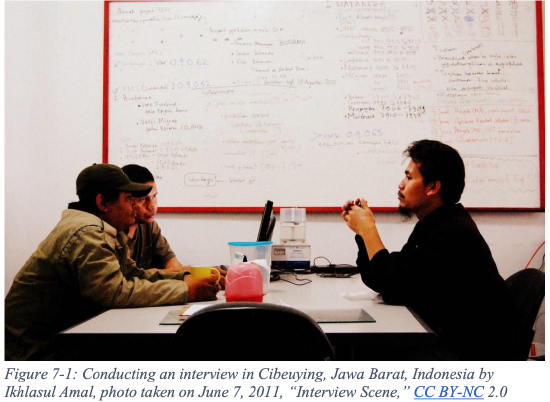Learning Objectives
By the end of this section, you will be able to:
● Explore interviewing as a qualitative research method
● Consider approaches to interviews such as interviewee selection, structured versus unstructured interviewing, and recording data
Simply put, interviews are conversations with relevant human subjects for the purposes of answering a research question. There is great variation in how to approach interviewing. Key decisions for researchers revolve around interviewee selection, whether to structure interviews or leave them unstructured, and whether to record what is said during an interview.
Interviewee selection hinges on identifying those individuals who possess the knowledge and experience to best answer a research question. Consider again the research question, “Under what conditions might Texas become a purple state?” Texas is a huge state, with a population in the tens of millions. To select interviewees whose responses might provide leverage in answering this research question, there are two approaches. Ideally, researchers would randomly select and then interview a sample of Texans which represents the diversity of the Texas electorate. For example, they might try to locate a mix of interviewees who represent the racial, ethnic, gender, religious, educational attainment, urban/rural, and other relevant dimensions of diversity among the state’s voters.
More realistically, especially for solo researchers just getting started, a second approach to interviewing is more network-based. This is nonrandom selection and involves interviewing Texans whom a researcher knows directly or through networks. A researcher might consult their address book for everyone they know who lives in Texas, then contact those Texans for interviews. Then the researcher might ask those contacts or initial interviewees to introduce them to other Texans who might want to discuss their political views. In this way the researcher can interview subjects with relevant knowledge, but the entire sample of interviewees may not be representative.
One significant upside of nonrandom interview selection is potentially having greater rapport with the interview subjects. When a researcher already has a relationship with an interviewee or has been introduced by a trusted third party, interviewees are more likely to be candid in their responses. Independent researchers often have to bow to reality and rely on nonrandom selection with the aim of getting as close to the ideal as possible. This opens the interview data to challenges of unreliability, but even with nonrandom information from interviews, the data obtained is more nuanced in terms of how voters actually think about their party affiliation and insights into trends in voter attitudes in Texas.

A second consideration is whether to conduct structured versus unstructured interviews. Structured interviews are interviews conducted with a pre-written set of questions which are read word-for-word to each interview subject. There is no deviation from these prescribed questions as the interview progresses. Structured interviews will yield higher levels of consistency and comparability in the data collected. For this reason, structured interviews are recommended if a team of researchers is fanning out to interview many subjects. Structured interviews are also recommended for less experienced interviewers who may benefit most from careful preparation and having a prepared script for an interview.
An unstructured interview is one where the researcher has a general sense of the topics or questions the interview will cover, but the intention is to ask follow-up questions in “real time” as the interview progresses. This is the most flexible approach to an interview. It also creates the most space for discovery and in-depth exploration of a topic during an interview. Unstructured interviews are ideal when a researcher is in the initial stages of exploring a research topic. On the other hand, unstructured interviews are also very demanding of the interviewer. The interviewer must be mindful of probing an interesting topic as much as possible while balancing constraints
such as being mindful other topics to cover, the time allocated for the interview, the energy levels of the interview subject, and other such considerations. Unstructured interviews run the risk of wandering too far off topic that important topics may not be discussed.
Interviews may also be semi-structured. These are interviews where the researcher has a prepared list of questions to ask, but the researcher is also willing to deviate from this list when a question piques their curiosity or demands additional follow-up questions not on the initial list. Semi-structured interviews seek to combine the benefits of structured and unstructured interviews and maximize, on the one hand, preparation by the researcher and, on the other hand, flexibility when encountering unexpected information.
A third consideration is whether and how to record interviews. Imagine the interview as a key site for data collection in the research project. Data from the interview must be collected and recorded, then merged with data collected from other interviews. This pooled data can then be analyzed or referenced when writing up research findings. A key initial step is for the researcher to decide how to collect data from the interview itself. There are a variety of ways to do this, but all data collection requires consent from each interview subject.
The simplest technology is pen and paper: write notes during the interview or immediately after to recall as much as possible of the conversation. A second option is recording the interview, either just a sound recording or video. Then, to analyze or reference content from the interview, it is important to transcribe the recording into text. This can be done using transcription software or manually transcribing a replay of the recording. Having a text of recorded interviews is critical to search the interview for key words or quotes that may inform research findings.
Which is recommended, handwritten notes or recording an interview? Handwritten notes have the advantage of setting and interview subject more at ease, as subjects tend to be more restrained when they know they are being recorded. Some interview subjects, especially public figures, may be more used to having their comments recorded and hence more readily grant permission. If the subject matter is sensitive, handwritten notes are likely the better choice. Recording the interview has the benefit of greater accuracy and allows the interviewer to focus more on guiding the interview rather than juggling notes and interview questions at the same time.
At some point, the data collected from an interview will need to be entered into a larger database. This can be as simple as creating a document or spreadsheet with notes from all the interviews conducted or using one of many open source software packages available for entering and analyzing interview data.
A note on conducting research on human subjects
Research which involves engaging with people, or human subjects, must be accompanied by protections for those subjects. This is critical for ensuring the integrity of the research project and the credibility of both the researcher and any sponsoring institutions. Research with human subjects will be addressed in the chapter on ethics in research.



